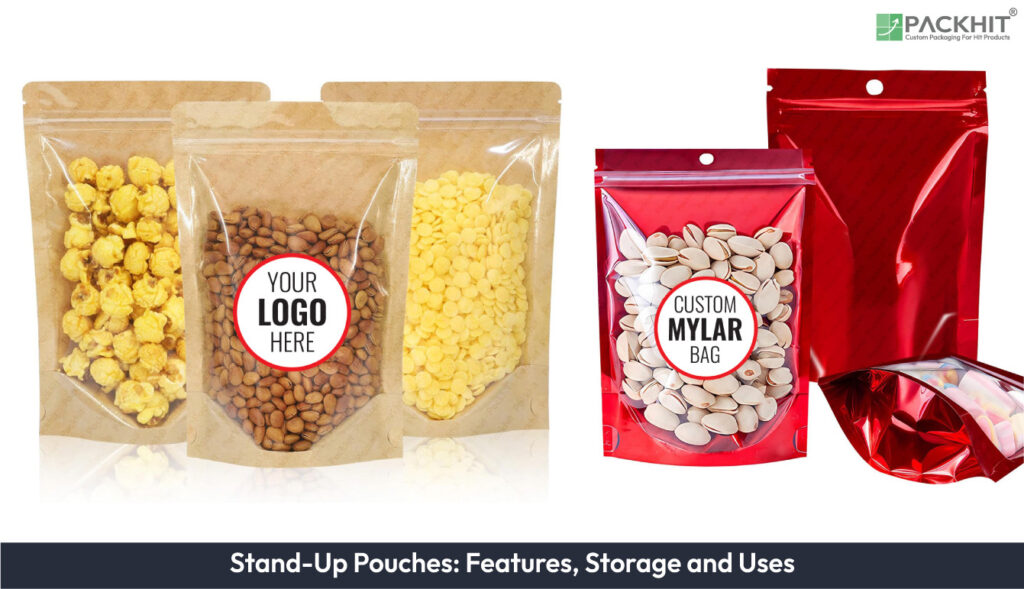Stand-up pouches are flexible packaging solutions with a gusseted base, enabling them to stand upright for effective retail display and storage. Constructed from multi-layered materials like PET, aluminum foil, and polyethylene, they combine durability, barrier protection, and adaptability for diverse products. Key structural elements include resealable zippers, tear notches, spouts, and hang holes, enhancing functionality and ease of use. These pouches optimize storage through their lightweight, compact design and ability to conform to product shapes, reducing waste and extending shelf life. Their applications span food, pharmaceuticals, non-food items, and eco-friendly products, offering features like moisture resistance, UV protection, and thermal stability. Stand-up pouches provide manufacturers with a cost-effective, sustainable option that reduces shipping costs, minimizes waste, and aligns with consumer preferences, making them a versatile choice for modern packaging needs.
What are Stand-Up Pouches?
Stand-up pouches are a type of flexible packaging designed to stand upright on shelves due to their gusseted base. This structural feature makes them ideal for retail displays and efficient storage. Typically constructed from multi-layered materials, such as laminated films, these pouches offer durability, barrier properties, and adaptability for various product types. Their design supports extensions like resealable closures, tear notches, and spouts, further enhancing functionality and consumer convenience.
What are the Structural Features of Stand-Up Pouches?
The defining structural feature of stand-up pouches is their gusseted base, which allows the pouch to stand upright when filled. This base can take various forms, such as a round-bottom, K-seal, or plow-bottom design, each tailored to specific weight and stability requirements. The body of the pouch is typically constructed from laminated films, combining layers of polyethylene (PE), polyester (PET), aluminum foil, or nylon to achieve strength, flexibility, and barrier properties.
Additional design elements include resealable zippers, tear notches, spouts, and hang holes. Resealable zippers enhance convenience for multi-use products, while tear notches ensure easy opening. Spouts are commonly integrated for liquid products, enabling controlled dispensing. Hang holes allow for vertical display in retail environments, optimizing shelf space utilization.
Material Composition and Barrier Properties
Stand-up pouches are constructed from multi-layered films, each layer serving a specific function. The outer layer, often made of PET, provides printability and resistance to external factors such as moisture and UV light. The middle layer, which may include aluminum foil or metallized films, acts as a barrier against oxygen, light, and odors, preserving product freshness. The inner layer, typically composed of PE, ensures heat-sealability and product safety by preventing contamination.
The barrier properties of these materials are quantified by metrics such as oxygen transmission rate (OTR) and water vapor transmission rate (WVTR). For instance, aluminum foil layers can achieve near-zero OTR, making them ideal for perishable goods requiring extended shelf life.
How Do Stand-Up Pouches Facilitate Storage?
Stand-up pouches are designed to optimize storage efficiency through their compact and lightweight structure. When empty, these pouches occupy minimal space, reducing transportation and warehousing costs. Once filled, their gusseted base ensures stability, allowing for vertical stacking and efficient use of shelf space.
The flexible nature of the materials used in stand-up pouches enables them to conform to the shape of the contents, minimizing wasted space. This adaptability is particularly advantageous for irregularly shaped products. Additionally, resealable closures and high-barrier films contribute to prolonged product freshness, reducing spoilage and waste during storage.
Temperature and Environmental Resistance
Stand-up pouches exhibit excellent resistance to a range of environmental conditions. Laminated films provide thermal stability, allowing the pouches to withstand freezing and moderate heating processes. For example, retort pouches, a subset of stand-up pouches, are designed to endure high-temperature sterilization, making them suitable for ready-to-eat meals.
Furthermore, the multi-layered construction protects against moisture, UV radiation, and chemical exposure, ensuring the integrity of the stored product in diverse storage environments.
What are the Primary Uses of Stand-Up Pouches?
Stand-up pouches are utilized across a broad spectrum of industries due to their adaptability and functional design. Their applications include:
- Food and Beverage: Commonly used for packaging snacks, dried fruits, nuts, coffee, tea, sauces, soups, and liquid products. Their high-barrier properties help preserve flavor, aroma, and nutritional content, making them ideal for perishable and aromatic goods.
- Pharmaceuticals and Nutraceuticals: Suitable for powders, tablets, and supplements requiring protection from moisture and oxygen, ensuring product integrity and extending shelf life.
- Non-Food Items: Frequently employed for detergents, pet food, fertilizers, and agricultural products, where durability, leak resistance, and ease of storage are critical.
- Specialized Products: Widely adapted for eco-friendly and organic products, leveraging their recyclable or biodegradable material options to meet sustainability goals.
These pouches are not only practical but also customizable, catering to a variety of packaging needs while maintaining product quality and consumer convenience.
Why are Stand-Up Pouches Relevant for Manufacturers?
For manufacturers, stand-up pouches represent a cost-effective and sustainable packaging solution. Their lightweight design reduces shipping costs and carbon emissions, aligning with environmental sustainability goals. The use of recyclable and biodegradable materials in some pouches further enhances their eco-friendly appeal.
Moreover, the adaptability of stand-up pouches to various product types and their ability to extend shelf life make them a practical choice for manufacturers aiming to optimize supply chain efficiency and reduce waste. Their aesthetic and functional attributes also contribute to improved marketability, driving consumer preference and brand loyalty.

